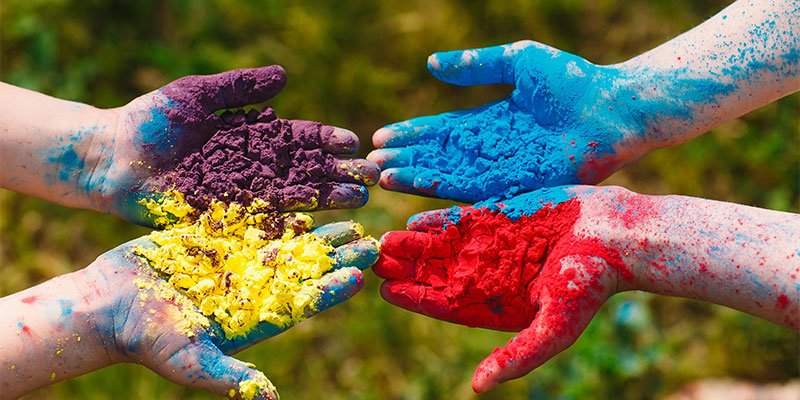Colors hold a significant place in our lives, as they can evoke memories, places, and seasons while also shaping our emotions. However, the symbolism and perception of colors, known as color symbolism in cultures, are largely influenced by the culture in which they are experienced. Common political and historical experiences, mythological and religious references, and language-related cultural factors play a significant role in shaping an individual’s perception of color. For instance, while white represents purity and cleanliness in Western culture, it is associated with death and mourning in Eastern cultures. These cultural variations highlight the importance of localization in color choices for brands aiming to successfully enter global markets.
Table of Contents
ToggleCommon Color Symbolism in Cultures
Whether we consciously recognize it or not, our perceptions of colors influence how we feel about things.
If we want to give an example to the color symbolism in cultures, the color black is frequently associated with generalities similar to death, anguish, fear, and mystery in the minds of numerous people. What comes to your mind when you hear the word” black” is incompletely told by the culture you live in. This relationship means that the colors you use in your marketing materials can unintentionally affect the message you’re trying to convey to an international audience.
While the amount and variety of color symbolism in cultures may seem endless, you can learn more about the subject in the continuation of our article.
1. Red
When we look at the color symbolism in cultures, red evokes excitement, danger, urgency, and love in Western countries, while it represents luck, long life, beauty, purity, power, seduction, and wealth in Eastern/Asian cultures. In the Middle East, it signifies caution, and even threatening situations, while in Latin America, it symbolizes passion and religious beliefs. In South Africa, it is associated with sacrifice and mourning.
Red is a prominent and attention-grabbing color wherever it is used. It is associated with different symbolisms and carries different meanings in each culture.
2. Pink
When we look at the color symbolism in cultures, in Western societies, pink is associated with femininity, love, and romance, while in Eastern societies, it carries genuinely different meanings. For illustration, in Japan, it’s associated with men, while in Korea, it symbolizes trust.
Pink is also believed to have a comforting effect on the mind, promoting relaxation and reducing aggression.
As a result of color symbolism in cultures, its usage is quite common in prisons.
3. Yellow
When we look at the color symbolism in cultures, yellow is considered the color of energy, happiness, and danger. It represents hope, happiness, visibility, attention, the warmth of the sun, and jealousy. In Eastern/Asian cultures, yellow symbolizes courage and prosperity, and it is often worn by members of the royal government class.
In the Middle East, it symbolizes nature, wealth, gold, and success. However, in Egypt and many regions of Latin America, yellow is associated with death and mourning. In some African countries, yellow is worn only by those who hold high ranks in society, as it is linked to wealth and success.
Yellow is a versatile color that carries different symbols and meanings in different cultures.
4. Green
Green is the dominant color in nature, symbolizing grass, trees, and leaves in most cultures. In Western cultures, green is associated with the environment, progress, and luck. It also has a calming effect and promotes growth and longevity. However, in some cultures, green is considered a forbidden color, representing exorcism and infidelity.
Green also holds strong symbolism in Islamic culture and is used in several national flags to represent the religion.

5. Blue
When we look at the color symbolism in cultures, blue is a color that is associated with various symbolism in different cultures. In Western cultures, blue represents security, authority, and tranquility, but it can also express sadness. Organizations like banks use blue to symbolize trust. In Eastern cultures, blue symbolizes immortality, healing, relaxation, and the sky. In the Middle East, blue signifies protection, spirituality, and the concept of heaven. In Latin America, blue represents freedom, infinity, and mourning.
Blue is also the color of stability, honesty, and calmness. It has a comforting effect on the body and mind.
This color, which represents trustworthiness, is generally perceived positively worldwide.
6. Black
Black, one of the most symbolically rich colors worldwide, holds a wide range of meanings. It is considered majestic, intimidating, and powerful. In Western cultures, black represents sophistication and formality, but it is also associated with death, darkness, and mystery. In China, black symbolizes energy and good health, while in Japan, it is linked to feminine energy.
In Latin America, black represents masculinity and is used for mourning. In the Middle East, black signifies mystery, mourning, and even rebirth. In Africa, black symbolizes maturity and masculinity.
7. White
The color white is commonly associated with illumination, purity, softness, spirituality, heaven, love, wisdom, and goodness. When we look at the color symbolism in cultures, while in Western cultures, it represents purity, innocence, and peace, in Italy, it is linked to funerals. In Eastern/Asian cultures, white signifies death, mourning, and misfortune.
In the Middle East, white evokes both purity and mourning. In Latin America, white symbolizes peace. In Africa, it represents goodness and good luck.
Universally, white is recognized as the color of purity, hence its frequent use in wedding dresses and baptismal gowns.
8. Orange
Orange is considered the color of fire, flames, passion, optimism, self-confidence, and inspiration. When we look at the color symbolism in cultures, in Western cultures, orange is seen as a wild and bold color.
In restaurants, orange symbolizes contentment, hunger, and stimulation.
Orange can be used to represent various transformations, such as harvest, autumn, and changing seasons. This color evokes a sense of energy and liveliness, while also being a symbol of fire, sun, and passion.
9. Purple
Purple is a magical color that symbolizes meditation and spirituality.
While purple is frequently associated with generalities similar to kingliness, wealth, and fame in Western culture, it’s also associated with death in certain regions of Europe.
In Asian countries, purple is generally linked to divinity and immortality, and nowadays, it also represents love and romance.
In the Middle East, purple is linked to wealth, and in Latin America, it symbolizes mourning or death. In Africa, purple is a symbol of royalty and wealth.
Throughout history, purple dye’s high cost has been associated with wealth. It is considered a rare color not commonly found in nature, carrying mystical meanings.
Localized Colors by Culture
The impact of colors on global marketing cannot be ignored. When we look at the color symbolism in cultures and its effects, colors can influence consumers’ buying behavior and evoke different emotions. The aesthetic appeal of a product or advertisement plays a crucial role in attracting new customers. However, the meanings and cultural values associated with colors can vary across regions and groups. Therefore, it is important to understand local cultures and make color choices that resonate with the target audience.
Amazon
Amazon prioritizes localization not only in its website design for different regions but also in its use of colors. For instance, the Amazon US site features a gray background with highlighted sections in black and blue. On the other hand, the Amazon Japan site is predominantly blue with limited use of gray and light colors. This demonstrates the adaptation of colors to align with the cultural expectations and preferences of users in each region.
Uber
As a globally operating company, Uber structured its color usage by taking cultural differences into account with the support of translation services. Previously, Uber used 65 different color palettes, but in 2018, they shifted towards simplicity and global usage. While it is important to demonstrate cultural sensitivity to adapt to different markets, Uber opted for a universal and straightforward global brand instead of a localized identity through colors and patterns.



